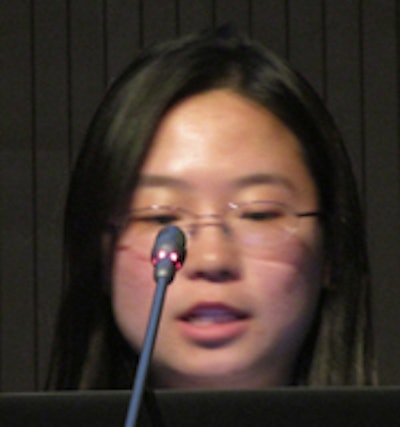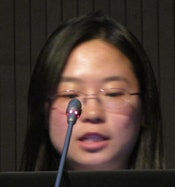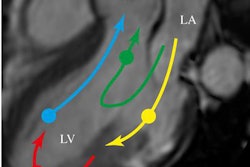
How low can a contrast dose go? Researchers have found excellent coronary CT angiography (CCTA) results with ultralow contrast and radiation doses when they tested several protocols with high-pitch dual-source CT scanning.
Searching for the optimal low contrast and radiation dose in high-pitch CCTA for patients who are not obese, a Beijing-based group settled on the remarkably small contrast protocol that included 25 mL of contrast at a concentration of 350 mgl/mL and a moderate flow rate.
"For nonobese patients, the use of ultralow protocols combined with high-pitch CCTA at ultralow tube voltage and SAFIRE [sinogram-affirmed iterative reconstruction] technique is feasible," said Yan Yi from Peking Union Medical College Hospital in Beijing.
Multiple dose-reduction technologies
CCTA has become the method of choice worldwide for diagnosing and screening for coronary artery disease in clinical practice.
 Dr. Yan Yi from Peking Union Medical College Hospital in Beijing.
Dr. Yan Yi from Peking Union Medical College Hospital in Beijing."However, contrast-induced nephropathy (CIN) has already been encountered to be one of the most significant issues for patients and their doctors, and it has been reported that contrast-induced nephropathy has been identified as the leading cause of hospital-acquired acute kidney injury," Yi noted in a presentation at ECR 2016.
The easiest way to avoid CIN is to reduce the use of contrast media, but little is known about how low contrast dose can go in high-pitch CCTA without reducing image quality.
Yi and colleagues aimed to investigate the feasibility and diagnostic value of dose-efficient high-pitch CCTA at low 70-kV levels with SAFIRE iterative reconstruction versus filtered back projection (FBP).
Their study cohort included 126 patients with suspected or known coronary artery disease but without prior intervention, including 84 patients with a body mass index (BMI) less than 25 kg/m2 and 42 patients with BMIs ranging from 25 kg/m2 to 28 kg/m2. Patients had to be at least 18 years old with resting heart rates of 70 beats per minute (bpm) or less.
The 84 patients with BMI less than 25 were divided randomly into group A (n = 22), group B (n = 20), and D1 (n = 20), depending on BMI. The latter 42 patients were divided into group B2 (n = 21) and group D2 (n = 21), again depending on BMI.
| Patient groups and contrast media protocols | ||||
| Patient group | BMI (kg/m2) |
Iodine concentration (mgl/mL) | Contrast volume (mL) | Injection flow rate (mL/sec) |
| Group A | BMI ≤ 25 | 300 | 25 | 2.5 |
| Group B1 | BMI ≤ 25 | 300 | 40 | 4.0 |
| Group B2 | BMI 25-28 | 300 | 40 | 4.0 |
| Group C | BMI ≤ 25 | 350 | 25 | 2.5 |
| Group D1 | BMI ≤ 25 | 350 | 40 | 4.0 |
| Group D2 | BMI 25-28 | 350 | 40 | 4.0 |
Contrast concentrations ranged from 300 mgl/mL to 350 mgl/mL, and volumes ranged from 25 mL to 40 mL.
The investigators acquired all images on a second-generation dual-source CT scanner (Flash, Siemens Healthcare) with tube voltage of 70 kV, tube current of 320 mAs, and Flash scan mode. Slice thickness and increment were both 0.75 mm. Images were reformatted using multiplanar reconstructions, maximum-intensity projections, volume rendering techniques, and consistent projection reconstruction. The raw data were constructed with SAFIRE iterative reconstruction and filtered back projection, the authors noted.
They chose size-specific effective dose estimates of CT dose index (SSDE-CTDIvol) along with effective radiation dose measures based on patient and background noise, signal-to-noise ratio (SNR), and contrast-to-noise ratio (CNR). They compared image quality based on coronary artery segment. There were no significant differences in baseline patient characteristics beyond the two BMI categories of 25 kg/m2 or less or the range of 25 kg/m2 to 28 kg/m2.
Higher contrast no help
In most cases, adding contrast volume or concentration didn't improve image quality. The results showed no significant difference in noise, SNR, or CNR for any coronary artery segments (p < 0.05) in subgroups B1 and D1, B2 and D2, or between group C and subgroup C and D1.
However, the SNR and CNR of each coronary artery segment in subgroups B1 and C -- where either concentration or volume was increased -- were significantly higher than those same measures in group A (both p < 0.05). The percentage of assessable segments in all groups was more than 98%.
In quantitative image quality with 40 mL of contrast, "there were no significant differences between group A and group B -- 300 mgl/mL of iodine was not different from 350 -- but there was a significant difference between protocol A and protocol C when we cut down contrast volume to 25 mL," Yi said.
Don't cut volume & concentration at same time
Boosting iodine concentration from 300 mgl/mL to 350 mgl/mL did not improve quantitative image quality measures. However, reducing iodine concentration from 350 mgl/mL to 300 mgl/mL while cutting contrast volume from 40 mL to 25 mL at the same time had a negative impact on image quality.
"That means when iodine concentration is cut down to 300, lowering the contrast volume may degrade image quality in patients, and there was significant difference in qualitative image quality," Yi pointed out.
The mean effective radiation dose for all exams was 0.22 mSv.
As for study limitations, not every case was compared to gold standard invasive angiography to evaluate stenosis detection, Yi said. The sample size for each group was relatively small. Finally, the results apply only to second-generation dual-source CT and may not be valid for other scanner models.
The researchers recommended the following:
- For patients with BMI of 25 kg/m2 to 38 kg/m2, use a protocol of 40 mL of contrast (300 mgl/mL) at an injection rate of 4 mL/sec.
- For patients with BMI of 25 kg/m2 or less, use a protocol of 25 mL of contrast (350 mgl/mL) at an injection rate of 2.5 mL/sec.



















